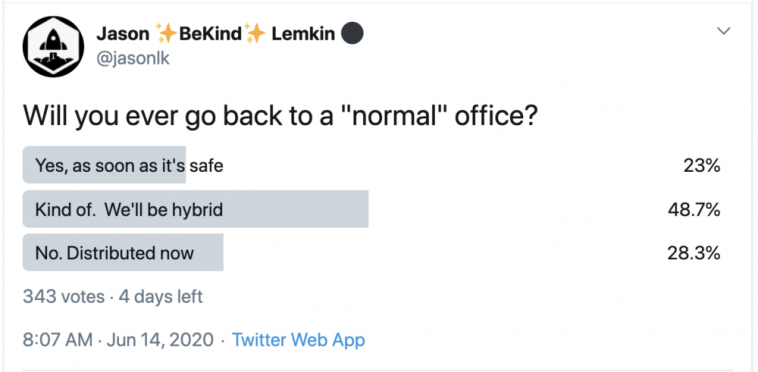- Like
- SHARE
- Digg
- Del
- Tumblr
- VKontakte
- Flattr
- Buffer
- Love This
- Save
- Odnoklassniki
- Meneame
- Blogger
- Amazon
- Yahoo Mail
- Gmail
- AOL
- Newsvine
- HackerNews
- Evernote
- MySpace
- Mail.ru
- Viadeo
- Line
- Comments
- Yummly
- SMS
- Viber
- Telegram
- JOIN
- Skype
- Facebook Messenger
- Kakao
- LiveJournal
- Yammer
- Edgar
- Fintel
- Mix
- Instapaper
- Copy Link
The pace of change recently has been breathtaking.
Just a few weeks ago, Stewart Butterfield, CEO of Slack, was kind enough to join us at SaaStr Summit: Bridging the Gap. He said Slack wouldn’t be going back to the office until September.
Now, just a few weeks later? Slack is going work-from-home forever. Along with Twitter and Square and Shopify.
I asked the SaaStr community where they stood, and 77% of you aren’t going back to a full-time office.
Even more will change in the coming weeks and months. But beyond real estate and the office itself, there are a few things we can all think about in SaaS:
- It’s already much easier to hire a “Bay Area VP” as a remote hire than before. This is profound. One of the top reasons to come to the SF Bay Area in SaaS was to hire your VPs. Because they are here. 80% of the SaaS leaders are still based in the Bay Area, and that also means 80% of your VP-level talent pool. Hiring them “remotely” was often impossible before. What VP doesn’t want to work in the same office as the CEO? But everyone being distributed has changed everything. I talk to tops of VP-level candidates in the Bay Area that are now 100% comfortable joining a start-up based elsewhere. Go hire 1 or 2.
- Field “offices” will still matter. We will start to visit customers in person again. And even if you don’t, the best distributed teams have all learned you want to be together in some fashion. In customer success and sales, that will still likely mean being closer to a customer geography. So maybe keep hiring in Europe if you have 15%+ of your revenue there. Etc.
- Folks are already moving to the edges of the Bay Area and other cities. Encourage that. Coming into the office 2 days a week, once it’s safe, creates a much wider geography you can pull from even if you are going Hybrid after all this. In the Bay Area, living in Sacramento, or Stockton, or Petaluma, etc. will become even more common.
- A lot of your team in the Bay Area may pack up. So encourage it and make it easy on them. Folks are leaving the SF Bay Area. Will be a tidal wave? Probably not, but who knows. In any event, if folks want to go back home, let them know you support them. The intense costs of the Bay Area aren’t for everyone. And right now, they don’t really make sense when you can’t take full advantage of the career benefits of being here. Make sure they know this is OK.
- Brands matter more. You can’t visit your customers. But your brand can. Brand matters more than ever. The Cloud leaders are growing faster than ever. They are the default choice.
- Salaries and comp may flatten, especially in sales and customer success. In the past 3 years especially, there has been huge comp inflation in sales professional in the Bay Area. Without a corresponding increase in the amount reps close. Paying sales and revenue professionals in SF far more than the rest of the country may be over. We will see.
- More CIOs are buying over Zoom. You always could sell a big deal over Zoom, it’s just you’d probably sell more, and increase your odds, if you visited in person. That will be true again soon enough, and if you don’t visit prospects (when it’s safe and when they want you), you may be at a disadvantage in the enterprise. But at least, selling to the enterprise is easier than every over Zoom. Because CIOs have adapted. We’ll discuss this more at SaaStr Enterprise in July (join us!!).
Published on June 15, 2020



